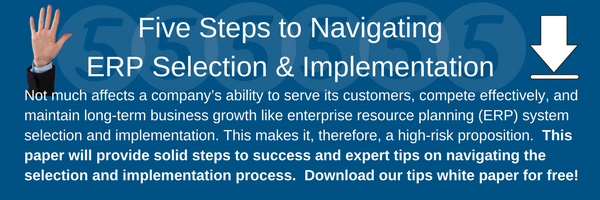Myth #4: "After the ERP implementation, all you have to do is use it."
When you buy a new car (and actually care about your investment), you don’t just drive it until the wheels fall off. If you want that car to last for a long time you regularly get the oil changed and tires rotated. When something seems to be wrong with your car, you get it checked out to get the maximum amount of performance and value for your purchase. It is the exact same way with an ERP implementation. Don’t waste all of that time, effort, and money your company put into getting a new ERP solution by not maintaining it. It is imperative that you keep your software working at optimal capacity with regular maintenance and upgrades as necessary. Some cloud-based solutions, such as Acumatica, can do upgrades automatically when authorized.
In the age of technology, nothing stays the same for very long in business, especially for ones with a supply chain complex or system, such as in manufacturing. As a manufacturer, you must complete a variety of tasks ranging from fulfilling customer orders to meeting government regulations. This means you have to deal with constant changes in your day-to-day operations. With that being said, your ERP system will need to stay up-to-date. Your vendor will make updates available to help your company gain as much functionality as possible.
Myth #5: "All ERP solutions are the same."
If every ERP was really the same, there would be no need for a buying process. As a matter of fact, the buying process for ERP is often a long and extensive one. This is because the company looking for the software must first evaluate what they need from the software, then review compatible ERP solutions' abilities, and what those differences between the ERPs will cost you. Some common areas of consideration are:
- Scalability
- Functionality
- Available modules/ISVs (product verticals)
- Implementation and maintenance costs
- Flexibility of service
There are many other things to consider when choosing your ERP, such as whether it’s a complete ERP solution with CRM, Finance, etc., or just a glorified spreadsheet and task manager. With so many ERPs that cater to different industries and levels of need, it is impossible for them all to be the same.
The differences between ERPs have been distinguished even further by the inclusion of cloud-based ERPs. Cloud-based solutions are ideal for fast-paced businesses that need an ERP that can update and change as quickly as they do. It is also ideal for professional service companies that have a lot of employees that work remotely and need mobility. Some cloud ERPs, like Acumatica, allow you to deploy the product in any way you need it, whether that is on a public cloud (SaaS), private cloud, or on-premise.
Clients First is an expert at implementing Acumatica, Dynamics AX, and Dynamics 365 (which also made it into Nucleus Research's "leader" quadrant). Contact our sales team today by calling 800.331.8382 or emailing info@cfbs-us.com. We train, implement, and support clients across the U.S.A. and in 11 countries and counting. Our team of professionals is ready to help implement the best finance and operations solutions for manufacturers, distributors, project-based manufacturers, MRO's (maintenance, repair, and overhaul), and professional services.
View the Data Sheet on Acumatica Cloud ERP
 5 ERP Myths You Believe, pt. 2">
5 ERP Myths You Believe, pt. 2">
